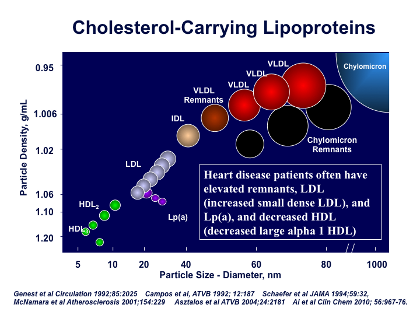Schaefer - Figure 3 - Lipoprotein particle spectrum Text
This Figure is a well-known chart of all of the lipoprotein particles. As intestinal particles come into the bloodstream from the gut and undergo lipolysis, patients with CVD or coronary heart disease (CHD) often have a variety of abnormalities in these lipoprotein particles. Lipid first enters the circulation as chylomicrons and chylomicron remnants of various sizes; these are lipid “globules” that have entered the bloodstream and undergone some digestion or lipolysis to become remnant particles. Once this lipid has passed through the liver it emerges encapsulated in lipoprotein particles that become progressively denser, from very-low-density lipoprotein (VLDL) particles all the way down to low-density lipoprotein (LDL) particles. Finally there are the HDL particles, which can be made directly by both the liver and the intestine.
What has been consistently observed using a variety of chemical analysis techniques is that patients with CVD/CHD often have derangements in this spectrum of particle sizes and compositions; these CVD/CHD patients:
- tend to have increased levels of the remnant particles;
- usually have increased LDL levels, but often predominantly the smaller, denser LDL particles;
- have increases in a genetically determined particle known as lipoprotein(a) (“LP little a”);
- have reduced HDL cholesterol, but these reductions are primarily in the very large HDL particles.
